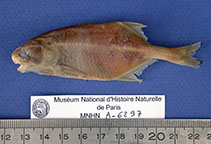| Family: |
Mormyridae (Elephantfishes) |
| Max. size: |
11 cm TL (male/unsexed) |
| Environment: |
demersal; freshwater |
| Distribution: |
Africa: Ogowe River in Gabon (Ref. 3203, 85311) and Congo River basin in Cameroon (Ref. 46901), Republic of Congo (Ref. 85311) and Democratic Republic of the Congo (Ref. 1879, 4910, 41580, 41590, 44985, 45434, 45441, 93897, 106245). |
| Diagnosis: |
Petrocephalus balayi is distinguished from all other Petrocephalus species in Central Africa by the following combination of characteristics: dorsal fin with 20-22 branched rays, anal fin with 26 or 27 branched rays, eye small (HL/ED=4,5-4,9), mouth very wide, associated with a very characteristic head shape when viewed from below, 14 teeth or more in the upper jaw, 28 teeth or more in the lower jaw (Ref. 85331). Melanin pattern consisting of the following: (1) a distinct black round mark on each side of the body below dorsal fin origin; (2) an ovoid mark on each side at the base of the caudal peduncle, not extending onto the upper and lower parts of the caudal fin; (3) a black mark, sometimes diffuse but always present, at the base of the pectoral fins (Ref. 85331). |
| Biology: |
|
| IUCN Red List Status: |
Least Concern (LC); Date assessed: 16 February 2009 Ref. (130435)
|
| Threat to humans: |
harmless |
Source and more info: www.fishbase.org. For personal, classroom, and other internal use only. Not for publication.

